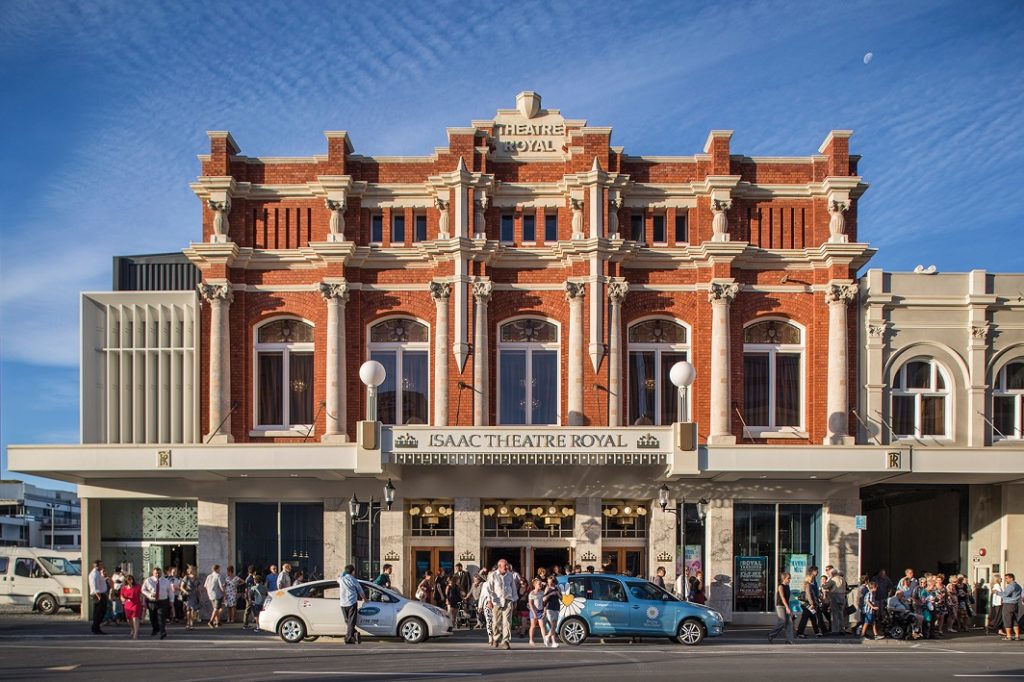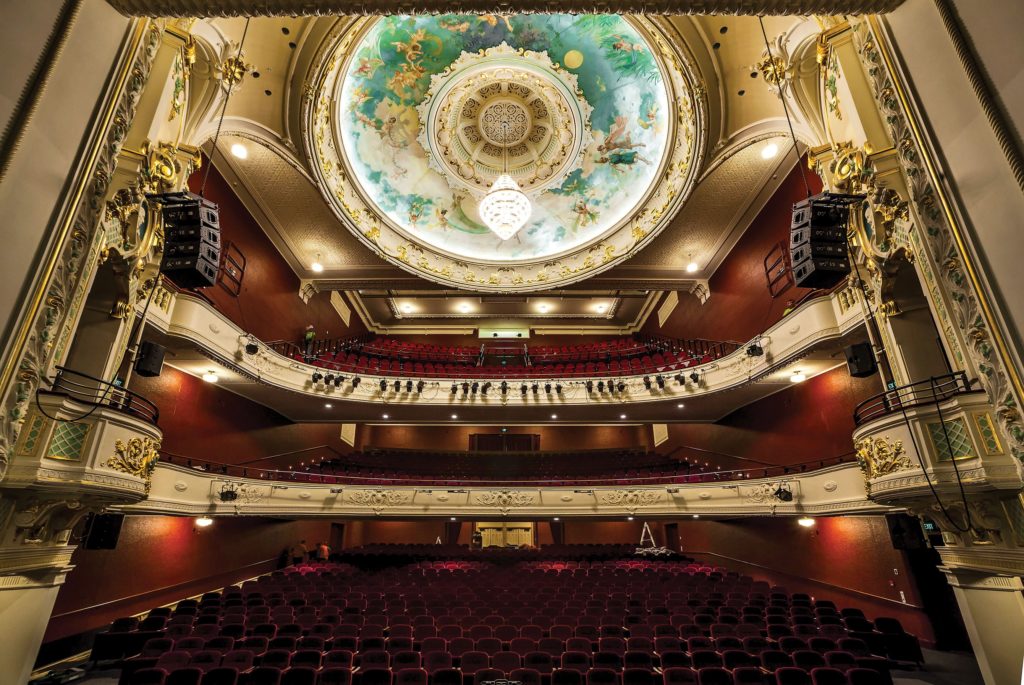
One of Christchurch’s most beloved heritage buildings deservedly scooped several major awards following an extensive restoration programme.
The elegant Isaac Theatre Royal had stood proud, tall and strong in central Christchurch for more than 100 years – until those fateful days in 2010 and 2011.
The Canterbury earthquakes did immense damage to a superb Edwardian-style theatre rightfully recognised as one of New Zealand’s premier venues for the performing arts.
The back of house and stage house that had been newly built in 2004/05 suffered only moderate damage and were repaired, but the 1908 auditorium and 1928 foyer spaces were beyond salvaging due to their dangerous original unreinforced masonry walls.
Extensive earthquake strengthening work undertaken in 1998/99 saved the “grand old lady of the performing arts’ from complete collapse, although some significant deconstruction was required to secure and protect the key interior and exterior heritage elements.
Brickwork had been severely damaged, there was a gap between the proscenium arch and the auditorium and the dress circle had slumped, while the theatre itself was flooded with cracked plasterwork, broken joinery and glass.
An August 2011 engineering report showed the main structural damage appeared to be confined to the auditorium, the adjoining poster room and office spaces, with liquefaction under the office area that hadn’t been previously strengthened.
Two significant aftershocks on June 13 and December 23, 2011 exacerbated the existing structural problems as floor slabs in the foyer moved on construction joints and the floor of the main auditorium sloped towards the eastern and western sides of the building.
As if that wasn’t bad enough, foundation beams running from the rear of the auditorium towards the stage were lifting at the edges, the auditorium’s walls had sunk noticeably and the western wall was about 10 to 20 millimetres lower than the east.
Consulting architects Warren and Mahoney were engaged to design and draw the plans for earthquake repairs, which included deciding whether to rebuild completely or restore the building back to its former glory.
“It started out as a $7 million repair project following the September 2010 quakes but after the 2011 quakes the damage to the structure progressively worsened to the point where we had to consider a total rebuild,” Warren and Mahoney Principal Architect Vanessa Carswell explains. “A decision had to be made as to whether we would try and rescue and incorporate as much of the heritage as we could or rebuild to a new design.”
That decision was, however, relatively easy. “By that point we had managed to save so much of the more important aspects of the heritage of the building,” Carswell recalls. “Everyone involved in the project, and in particular the trust that owned the theatre, saw the value of retaining a well-loved building that was part of the city’s fabric – it became even more important to rescue it when other heritage buildings were being demolished.”
The project team had two warehouses full of “a jigsaw puzzle of pieces” of salvaged elements of the building, plus several shipping containers on site, which also helped the decision-making process.
“The main heritage elements of the building are the central dome in the auditorium, which is quite large – about 10m in diameter – the main foyer marble staircase and the facade.”
Earthquake strengthening completed in early 2000 helped the building hold together through the quakes – with a little bit of help from temporary propping – so the heritage elements were relatively secure.
There were also a lot of other elements such as architraves, ceilings, doors and plaster mouldings that had been taken out and rescued piece by piece while the 2011 aftershocks were occurring.
“We could foresee a good strategy to rebuild and retain the stair and facade in situ and also developed a methodology to remove and reinstate the dome,” Carswell adds.
Rebuilt and restored
The Isaac Theatre Royal board accordingly decided the edifice had too much history to lose forever, so the existing theatre would be deconstructed before being rebuilt and restored to exceed the building code’s earthquake resistance requirements.
The auditorium’s brick walls would be replaced by strengthened steel and concrete walls and a lightweight reinforced steel beam roof installed beneath reinstated plaster work.
A hydraulic pit lift would provide an extendable stage while adjusting the pitch of the roof would enable a new foyer space to be built in the upper-level gallery, which had previously had no foyer and was only accessible by a 96-step staircase.
Finally, a multipurpose performance and function space would also be constructed adjoining the dress circle foyer, along with new ticketing sales facilities and relocated office space.
Fittingly the daunting task of renovating, restoring and rebuilding the city’s leading arts venue fell to Naylor Love, itself an equally established 100-year-old firm that began operations in Dunedin in 1910.
Naylor Love was very familiar with the building and its idiosyncrasies and challenges, having given the theatre a mainly back-of-house refurbishment in 2004-5 that had won several awards at the 2006 Canterbury RMB Commercial Project Awards.
Naylor Love in turn commissioned leading engineering and design consultancy Harrison Grierson to monitor the building for any movement in the building level or heritage façade during the restoration works.
“We were also charged with determining the relationship between existing legal boundaries and the existing building and setting out gridlines for the restoration works,” recalls Harrison Grierson Senior Surveyor Rita Clark.
Similar to the Christchurch Town Hall restoration project in which the firm also participated, the Isaac Theatre project boasted several special features. “There were significant heritage elements that had to be protected,” Clark explains. “The survey control and monitoring marks had to be carefully selected and constructed, including temporary marks, to avoid or minimise the potential for damage to any heritage elements.”
Foremost among the building’s numerous heritage elements was the magnificent 10m-diameter dome, which soared above the three seating levels and was crowned with an Italianate painting of scenes from A Midsummer Night’s Dream, by G.C. Post of the Carrara Ceiling Company of Wellington.
Made up of eight separate canvases, four large and four small installed in an overlapping configuration, the painting presents a selection of images from what is arguably Shakespeare’s most whimsical comedy.
However, the project was significantly more elaborate in design and complexity of construction than originally estimated with the theatre being rebuilt from façade to proscenium arch.
“As the aftershocks continued, the scope of works changed into a complete rebuild of the foyer and auditorium, including the addition of several upgrades such as an extendable stage, a new performance space and upper-level foyer and a lift,” Naylor Love General Manager Pete Lockhart explains.
One of the key drivers for the project was to allow patrons to return to the theatre without noticing the difference, with the decorative plaster and other heritage features installed over the new strengthened steel and concrete walls and a lightweight reinforced steel beam roof.
“We used 3D scanning of the building to allow the design team to detail the reinstatement to its pre-earthquake condition, with features that could not be preserved faithfully, replicated.”
The design team quickly came to the realisation that they had go through a process of designing and redesigning while the building was being demolished. “Once a structure like that starts to unzip and effectively demolish itself it needs to be rebuilt as quickly as possible otherwise the weather will quickly degrade it,” Carswell notes.
The design was therefore split into 17 different consent packages and progressively submitted both for consent and to the contractor in order to fast track the project. “Alongside that we had three floods, one fire and were having to work in the red zone, which had no infrastructure and no electricity.”
As if that wasn’t enough, there were also archaeological issues. “We had to apply for an archaeological resource consent that we had to respect when we dug the foundations,” Carswell says.
Dewatering and the numerous legislative changes that occurred as a result of the earthquakes also had to be factored into the rebuild process. “It was quite an unusual design and shape, so we had to undergo BRANZ testing on various aspects of the design for both structure and fire safety.”
Faithful features
Other problems surfaced when it came to preservation of the historic features, which included the dome, the restoration of the brick and Oamaru stone façade, marble staircase and an intricately painted auditorium, not to mention the early 20th-century decorative plasterwork.
Unfortunately, recovering most of the plaster decoration wasn’t practical as the horsehair and vegetable-fibre reinforced ornamentation hadn’t survived the earthquakes in great shape, and would have been unsafe to reinstall.
It was therefore decided to take moulds of each section of the existing plasterwork to ascertain how new sections could be grafted onto the older details to create a seamless effect indiscernible to the naked eye.
Protecting the dome in the unstable building was another major challenge, Lockhart notes.
“We worked closely with the engineer and stabilised the building from the outside, allowing access to the dome.”
The dome was a timber structure that was integrated into the timber trusses of the roof, but while the side walls of the auditorium were solid brick they were progressively pulling themselves apart and bowing outwards by almost a metre.
“The whole structure was becoming unsafe and the trusses were effectively tying the whole building together across the top,” Carswell explains. “The structural engineer and the main contractor managed to work up a very clever methodology to cut the trusses and remove the connection between the dome and the trusses.”
A cradle was devised so the dome could be lowered down inside the building, then pulled through the proscenium arch and secured safely on the stage while the deconstruction work was carried out around it.
“As soon as we cut the trusses in two the whole building was at risk of collapse, so it was all done within an hour and the auditorium was immediately and progressively demolished after that,” Carswell observes.
The canvas was then removed in pieces into one of the rooms within the theatre, which needed to be kept dust-free and at a constant temperature for the intricate conservation work.
A further challenge was the need to keep the marble staircase in the main foyer in place throughout the whole rebuild. “They were extensively propped and had to be protected,” Lockhart explains.
Work continued apace throughout 2013 with reconstruction and strengthening of the walls followed by the delicate process of lifting the two main sections of the new roof into place, including the roof trusses and secondary steel supports.
An added complication resulting from the earthquakes was the reconfiguration of the land under the theatre that exacerbated the threat of flooding, a problem solved by drilling a permanent borehole in the theatre’s loading alley.
This provides a dewatering system that keeps the rising water table at bay courtesy of an automatic trigger 15 metres underground that begins dewatering when the water level rises above the switch.
Extra safeguards have been built into the system with two pumps strategically located below the new hydraulic stage extension that ensure the auditorium remains dry despite outside weather conditions.
The rebuild and restoration faced significant challenges throughout, making it one of the most intricate building projects in the earthquake-damaged Christchurch CBD with an overall rebuild cost of NZ$40 million.
The superbly restored and revitalised theatre finally reopened on 17 November 2014 with many of its original Edwardian features intact, having achieved 100 per cent of the new earthquake building code.
“This incredible project has returned the Grand Old Lady of Christchurch theatre to her original Edwardian interior splendour, as well as significantly upgrading the theatre’s public spaces and technically enhancing and future-proofing the venue for many generations to come,” Isaac Theatre Royal Chief Executive Neil Cox says.
“It was a significant effort from start to finish with a very talented and dedicated team of design consultants, all of whom became as passionate and excited about the rebuild and restoration as ourselves.”
Carswell is equally proud of the project. “We managed to bring it up to the standard of a modern theatre – we’ve brought it up to speed in terms of its technical capabilities by adding a stage lift, 400 square metres of front of house foyer space, cinema capability and an additional event space that is linked to one of the foyers, as well as rearranging the office and administrative space and upgrading the HVAC system, data and other technological aspects,” she explains.
“It was a great achievement to see this theatre brought back to life in a way that frankly wouldn’t have happened if the earthquakes hadn’t happened – we’ve managed to give it another 100 years or more of life that it really needed before the earthquakes.”
The Isaac Theatre Royal restoration fittingly won top prizes in the 2015 Property Council New Zealand and Rider Levett Bucknall Awards – gold in the Hawkins Heritage and Adaptive Reuses and merit in the Coffey Education and Arts Property categories.
The annual awards celebrate excellence in property development based on economic and financial factors, project vision and innovation (including degree of difficulty), design and construction, owner and user satisfaction, and sustainability and efficiency of operation.
The Isaac Theatre Royal was also recognised in the Property Council of New Zealand Southern Excellence Awards 2015, the Best Project Team Award deservedly falling to the Isaac Theatre Royal, Warren and Mahoney, RCP, Naylor Love and team.
As if that wasn’t impressive enough, the theatre won a Canterbury Heritage Award in the Public Realm Saved & Restored category in May, as well as the Retail/Hospitality Small Enterprise Award and The Press Champion Supreme Small Enterprise Award in September’s Champion Canterbury 2016 Awards.
However, these prestigious accolades matter little to the people of Christchurch, who rightly regard the Isaac Theatre Royal as an inspirational example of hope – not only for themselves but for all Cantabrians.
The Isaac Theatre Royal team:
Project managers: RCP, Holmes Consulting Group
Building contractors: Naylor Love
Geotechnical engineers: Tonkin and Taylor
Hydraulic and mechanical engineers: Powell Fenwick
Architects: Warren and Mahoney
Structural engineer: Holmes Consulting Group
Fire engineer: Holmes Fire and Safety
Surveyors: Harrison Grierson
Electrical engineer: Neil Pritchard
Isaac Theatre Royal technical contractor: Andre Goldsmith
Designated heritage architect: Tony Ussher
This article appeared in the August issue of Asia Pacific Infrastructure News.




